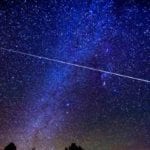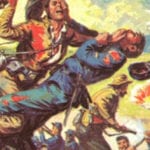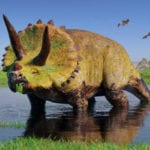 History
History  History
History  Technology
Technology 10 Surprising Truths About the Power Grid You Were Never Told
 Food
Food 10 Most Outrageous Restaurant Food Challenges
 Facts
Facts 10 Interesting and Bizarre Facts About Vending Machines
 Technology
Technology 10 Ancient “Smart” Materials Scientists Still Can’t Reproduce
 Gaming
Gaming 10 Games Milked for All Their Worth
 Our World
Our World 10 Things That Will Make You Rethink Everything Normal
 Animals
Animals 10 Times the Christian Church Took on the Animal Kingdom
 Weird Stuff
Weird Stuff 10 Big Ideas Born in British Pubs
 Travel
Travel 10 Perilous Hikes Still Open to the Public Today
 History
History 10 Doomsday Scenes from the Year Without a Summer
 Technology
Technology 10 Surprising Truths About the Power Grid You Were Never Told
 Food
Food 10 Most Outrageous Restaurant Food Challenges
Who's Behind Listverse?

Jamie Frater
Head Editor
Jamie founded Listverse due to an insatiable desire to share fascinating, obscure, and bizarre facts. He has been a guest speaker on numerous national radio and television stations and is a five time published author.
More About Us Facts
Facts 10 Interesting and Bizarre Facts About Vending Machines
 Technology
Technology 10 Ancient “Smart” Materials Scientists Still Can’t Reproduce
 Gaming
Gaming 10 Games Milked for All Their Worth
 Our World
Our World 10 Things That Will Make You Rethink Everything Normal
 Animals
Animals 10 Times the Christian Church Took on the Animal Kingdom
 Weird Stuff
Weird Stuff 10 Big Ideas Born in British Pubs
 Travel
Travel 10 Perilous Hikes Still Open to the Public Today
10 Oddities Sent Into Space
From the minute we started sending humans into space, authorized and unauthorized paraphernalia have gone with them. Even unmanned spacecraft hauled oddities to the far reaches of our solar system. Here are a few items that have reached where most of us will never go.
10Toys
Beginning in 1985, when the shuttle Discovery took 11 toys into space, playthings have made regular trips above the ethers. They are usually part of educational programs, where astronauts or cosmonauts record themselves playing with the toys to demonstrate how they perform in microgravity. STS-54 (1993) took 40 toys into space, and STS-77 (1996) carried 10. Sixteen more toys and sports-related equipment went up to the roomier International Space Station to be tested, and web videos were available to classrooms around the world as a part of the “International Toys in Space” program.
As a part of the STEM (Science, Technology, Engineering, and Mathematics) Program, the Pixar spaceman Buzz Lightyear caught a ride on the Space Shuttle Discovery’s STS-124 mission to the International Space Station (ISS). The 30.5-centimeter (12 in) action figure orbited Earth on the station for 468 days, playing online learning games with Earth-based elementary school kids and hosting science lessons.
When Buzz came back to Earth on September 11, 2009, he was given a ticker-tape parade at Walt Disney World just in time for the opening of the park’s “Toy Story Mania!” attraction. He was then installed in the Smithsonian.
9Firearms
Beginning in 1986, all Soviet and Russian space missions carried a TP-82 triple-barreled pistol with them. It could shoot bullets or signal flares. Its detachable stock doubled as a machete. It was to be used not against suspected alien enemies but Siberian wolves or musk deer and was inspired by the disastrous Voskhod 2 mission.
In March 1965, Aleksey Leonov became the first human to perform an extra-vehicular activity (EVA), hovering in the vacuum outside the spacecraft. Leonov’s suit became over-pressurized, ballooning to such an extent that his feet were no longer in their boots, his hands no longer in their gloves. He could no longer reenter the spacecraft feet-first and had to wiggle inside head-first while bleeding pressure from his suit.
Things got worse when they tried to reenter Earth’s atmosphere. The automatic guidance system was not functioning properly, and the cosmonauts had to reenter manually. Worse, they had only enough fuel for one course correction. Their capsule parachuted them 1,500 kilometers (930 mi) west of their intended landing site, deep in a thickly wooded Siberian forest. And it was mating season, when Siberian wolves and bears were at their most aggressive. They did have a pistol but had little else to survive in the wilderness. Fortunately, they were found just hours after landing and were rescued the next day, skiing 9 kilometers (5.6 mi) to a site clear enough for a helicopter extraction.
In 1968, a survival kit was developed for all Soviet space missions and included a Makarov pistol. The Makarov was replaced with the TP-82, and in 2006, the TP-82 was replaced with a semi-automatic pistol. And, yes, the automatics are still part of Russian survival kits, and that means the cosmonauts occupying ISS are indeed packing.
8Pornography

When NASA sent Apollo 12 to the Moon in November 1969, the backup crew played a joke on the primary astronauts. After the Landing Module touched down on the Oceanus Procellarum (Ocean of Storms), Charles Conrad and Alan Bean took a walk on the lunar surface. When they opened their EVA checklists attached to their wrists, they were surprised to find Playboy centerfolds inserted with witty remarks.
Conrad’s cuff checklist had a spread of Angela Dorian (Miss September 1967) with the line “Seen any interesting hills & valleys?” written beneath it. On another page, Reagan Wilson (Miss October 1967) was displayed as a “Preferred tether partner.” Bean’s cuff checklist had Cynthia Myers (Miss December 1968) and “Don’t forget—describe the protuberances” on one page. On another was Leslie Bianchini (Miss January 1969) and “Survey her activity.”
Back up in the orbiting command module, Richard Gordon was surprised to find a playmate—DeDe Lind (Miss August 1967)—taped to his locker with the label “Map of a Heavenly Body” attached.
7Luke’s Lightsaber

Some paraphernalia were taken into orbit for no reason other than to say it was in space. During the shuttle program, each mission carried an Official Flight Kit (OFK) where personal items were stowed for the flight. The items were often chosen so they could be later given out as gifts.
As an example, when the shuttle Discovery lifted off in October 2007 for a two-week mission to the ISS, it carried 102 items in its OFK. Seventy-six of those items belonged to crewmembers. Each crewmember is allowed about 1 kilogram (2 lb) of paraphernalia in the OFK.
Flight Commander Pam Melroy had banners from her nephew’s school district and her college alma mater placed in the OFK. Mission Specialist Doug Wheeler, who had befriended childhood hero Bobby Murcer after the former New York Yankee was diagnosed with a brain tumor, had placed Murcer’s jersey and baseball card in the OFK, planning to give them to Murcer as gifts.
Some crewmembers took mementos to thank places and organizations that had helped them attain a seat on the shuttle. Things like patches, flags, medallions, pins, photos, and posters were handed out after the flight. NASA and its contractors, too, pack presentation gifts such as patches, pins, bookmarks, banners, and even a copy of the Italian Constitution.
One item placed in the STS-120’s OFK was the lightsaber prop used by Luke Skywalker in Return of the Jedi. George Lucas asked for it to be taken into space in honor of the 30th anniversary release of his Star Wars: A New Hope.
The lightsaber spent the entire flight in its Styrofoam box. Almost all the items in the OFK never leave their storage spot in the OFK during the mission.
6Pocket Change

Coins may seem too mundane to be considered an oddity, but if you think about it, why would astronauts need them? For all those interstellar toll booths and suborbital vending machines?
Taking stuff into space just to elevate their worth didn’t start with the shuttle program. Gus Grissom did it all the way back in July 1961 when he became the second American in space. Grissom’s 15-minute suborbital flight ended with a splash in the Atlantic Ocean. While he was waiting to picked up by a helicopter from the USS Randolph, Liberty Bell 7’s hatch blew open and water began pouring in. Grissom swam out the hatch.
While treading water and barely keeping his head above the surface, Grissom realized that in his left leg pocket he had two rolls of 50 dimes, 30 one-dollar bills, some models of Liberty Bell 7, and two sets of pilot wings. They were all souvenirs he’d planned to hand out after the flight. The extra weight was pulling him down. Fortunately, a copter soon rescued him.
His capsule, however, sank, and with it went a stash of older coins—so-called Mercury-head dimes from 1935 to 1945—that Grissom had wanted to use as gifts. When the Liberty Bell 7 was recovered in 1999 from a depth of 4,900 meters (16,000 ft), 52 Mercury-head dimes were also recovered, one of them pictured above.
5Product Promotions
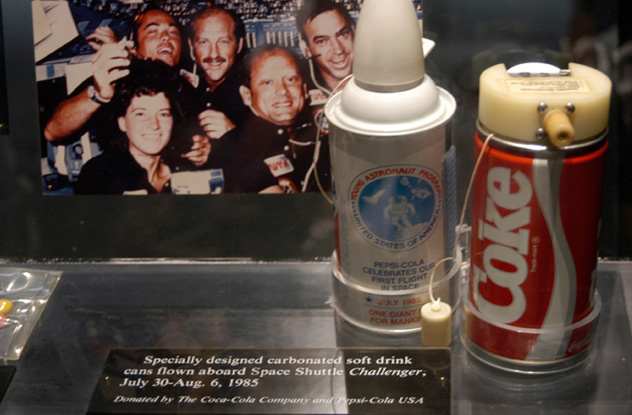
Spaceflight has long had an uneasy partnership with advertising. NASA gave Life magazine exclusive access to the original Mercury 7 astronauts and their wives. Life churned out articles and even a few books depicting the astronauts and their families as average, middle-class Americans. In exchange, the magazine provided the astronauts with huge life insurance policies.
When Apollo 11 landed on the Moon in July 1969, 94 percent of American televisions were tuned in. That was advertising exposure no company could pass up. Every contractor that had anything to do with sending Apollo 11 on its lunar excursion developed elaborate press kits with the flight’s logo emblazoned on the cover. Tang became the drink for “spacemen and Earth families.” Omega Watches became the watch astronauts wore on the Moon.
Then Coke got into the act when they spent $250,000 to develop a can that would dispense Coca-Cola in zero gravity. The company even changed their formula to make the beverage easier to drink because carbonated drinks are difficult to keep in the stomach at zero gravity. When Pepsi got wind that NASA had agreed to send the Coke dispenser up on a shuttle, they spent $14 million to develop a “space can” of their own.
Thus began the “Cola Wars in Space” that even lassoed proponents in Congress into the debate. Coke suddenly became the preferred drink of Democrats, while Pepsi found favor with the Republicans.
Finally, the Challenger shuttle was sent into orbit in 1985 with four cans of each cola. The five-person crew tested the drinks out and hated both brands. That didn’t stop Pepsi from launching a media blitz, calling their product “one giant sip for mankind.”
Even the Russians got in on the act. In 2000, Pizza Hut launched a campaign to make their image more contemporary and international. That year, they sponsored the Russian space agency and plastered a 9-meter (30 ft) logo on the side of an unmanned Proton rocket delivering the Zvezda module to the ISS. The next year, they went one step further by delivering a 15-centimeter (6 in) salami and cheese pizza to the ISS crew. Salami had to be used because pepperoni turned moldy when Pizza Hut tested it in space. Cosmonaut Yuri Usachov microwaved the pie and toyed with it in zero gravity before he ate it. He gave it a thumbs-up.
4Message Bottles Launched Into The Cosmic Ocean
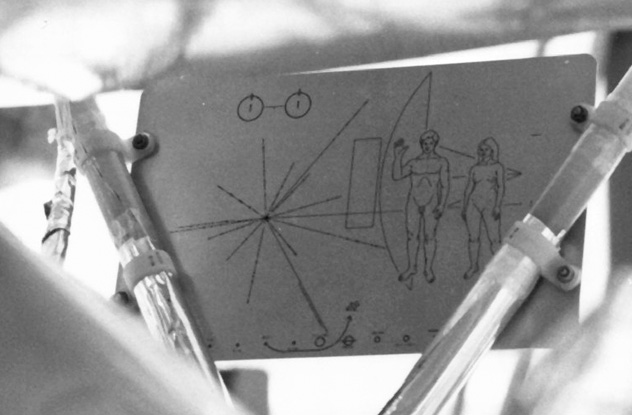
After the New Horizons probe finishes its five-month study of the dwarf planet Pluto in 2015, it will become the fifth man-made object to leave our solar system. Attached to its hull at various places are containers with keepsakes such as a CD-ROM with photos of the New Horizons project personnel, Maryland and Florida state quarters (the states where the probe was built and launched respectively), and a US postage stamp depicting Pluto. A piece of metal from Spaceship One, the first privately owned manned spacecraft is also attached to the probe. In a small, cup-like container welded to the hull are the ashes of Clyde Tombaugh, the man who first discovered Pluto way back in 1930. Last of all is another CD-ROM with the signatures of some 400,000 inhabitants of Earth, a kind of salutation to the stars.
Four other spacecraft have ventured beyond our solar system, and all four have human greetings for extraterrestrials. Just before Pioneer 10’s 1972 launch for Jupiter and the great beyond, Carl Sagan designed and attached a gold-anodized aluminum plate. On the plate was a visual message to anyone or thing that might intercept Pioneer 10, drawn by Sagan’s wife Linda, telling them who sent the spacecraft and where and when it began its journey.
The key to the message are the two circles in the left corner of the plaque which depict hydrogen, the most plentiful element in the universe. A line between them represents an electron energy transition called a spectral line. In hydrogen, this spectral line has a set wavelength (21 centimeters) and set frequency (1,420 MHz).
Using the set length, the plaque gives the average height of humans, the distance the Sun is from the center of the Milky Way, the distance each planet in our solar system is from the Sun, and the distance the Sun is from 14 interstellar pulsars. All this pinpoints our location. And because the pulsars and our sun are always moving at a set speed, the alien can calculate when Pioneer was launched using the spectral line’s set time. An identical plaque was affixed to Pioneer 11. In his biography, James Van Allen, discoverer of the Van Allen Radiation Belt, said he managed to put his fingerprint on the Pioneer 10 plaque.
Five years later, when Voyagers 1 and 2 were launched to tour the outer solar system, Sagan put together a far more ambitious interstellar message. It was carried on a 12-inch, gold-plated copper disk, and Sagan claimed it was kind of message in a bottle, launched into the “cosmic ocean” to tell extraterrestrials the story of humankind.
The record features 115 images, along with natural sounds (such as surf, thunder, and bird songs), musical selections, a message from President Jimmy Carter, and greetings in 55 human languages.
3A Secret Inside Joke
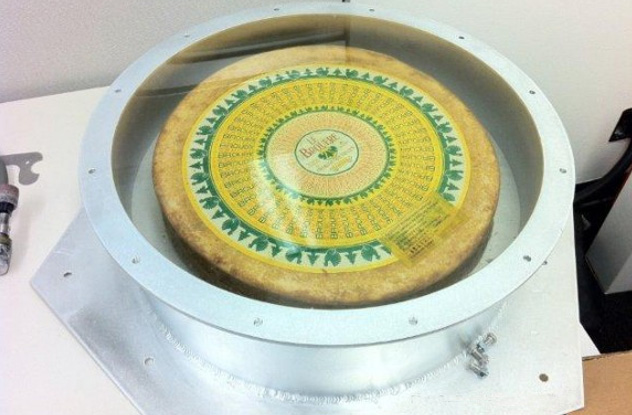
In December 2010, the California-based company SpaceX launched their Dragon unmanned spacecraft. The capsule orbited Earth twice then safely splashed down 804 kilometers (500 mi) west of Mexico in the Pacific, becoming the first commercial spacecraft to successfully do so. It was a test flight of the robotic Dragon in preparation for 12 cargo flights SpaceX will carry to the International Space Station after the shuttle fleet retired in 2011.
The test flight’s only cargo was hidden in a drum bolted to the floor of the capsule with the words “Top Secret” and a spotted cow sporting galoshes imprinted on the lid. This was a reference to the 1984 comedy Top Secret. Rumors circulated about what might be inside, and once the Dragon lifted off, SpaceX’s CEO Elon Musk dropped a hint: “If you like Monty Python, you’ll love the secret.” Many speculated that it was a can of Spam, a reference to “Spamalot” from Monty Python and the Holy Grail.
Once the Dragon had successfully splashed down, SpaceX released photos of large wheel of Gruyere cheese nestled inside the drum. It was a nod to a Python skit where John Cleese tries to order cheese at a cheese shop that has no cheese. Musk later said that he himself shopped for the cheese in Beverly Hills, purchasing the largest wheel he could find.
2Armchairs, Shellacked Hamburgers, Beer, and Bacon
For the cost of $60, you can purchase a 60-gram balloon that can lift an 800-gram (1.9 lb) payload to 32,000 meters (105,000 ft) or a 2.3-kilogram (5 lb) payload to 26,000 meters (87,000 ft). The boundary between the atmosphere and space—called the Karman line—is at 100,000 meters (328,000 ft), and near space begins at 23,000 meters (75,000 ft).
Some people use the near space balloons to experiment. In July 2012, students sent petunias in a vase to the stratosphere, where the flowers froze at temperatures of – 63 degrees Celsius (–81 °F). Others are inspired for artistic reasons. Azuma Makoto, an artist in Japan, sent a bonzai tree and a floral arrangement into near space and filmed them in a project called Exobiotica.
Others send things skyward for publicity. Two friends contacted Anheuser-Busch to ask if they could make Natural Light the first beer in space. The company agreed, and the above video was the result. Toshiba strapped two of its high-definition cameras and a chair to a helium balloon and sent them to 30,000 meters (98,000 ft) for a commercial.
Still others just do it for fun. Five Harvard students shellacked a two-day-old burger and sent it to the stratosphere. It was inedible when it returned to Earth. Bacon, however, was hoisted aloft by members of British cricket club and was later cooked and eaten.
1Mortal Remains
Celestis Memorial Spaceflights sends the ashes of loved ones into space, piggy-backing on a commercial or scientific satellite. The remains are sealed in a container and placed on the Celestis spacecraft, which is then attached to the host rocket. Families gather to watch the liftoff and receive a keepsake DVD.
The first flight was in April 1997 and carried the ashes of such luminaries as Star Trek creator Gene Roddenberry and psychologist and psychedelic drug advocate Timothy Leary.
Eugene Shoemaker was a pioneer of astrogeology and was picked to be the first geologist to journey to the Moon during the Apollo program. But when he was diagnosed with Addison disease, his dreams of going to the Moon were dashed. After his death in 1997, Celestis sent his ashes to the Moon, where his ship impacted near the lunar south pole in 1999. The impact crater stands as his memorial.
Others who have been launched into space include James Doohan (Scotty in the original Star Trek series) and Gordon Cooper (one of the original Mercury Seven astronauts). Beginning in 2015, Celestis plans to send the ashes of pets into space. Packages begin at $12,000.
Steve is the author of 366 Days in Abraham Lincoln’s Presidency: The Private, Political, and Military Decisions of America’s Greatest President and has appeared in KnowledgeNuts.
